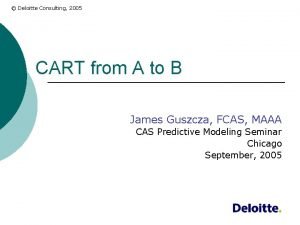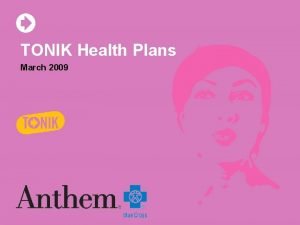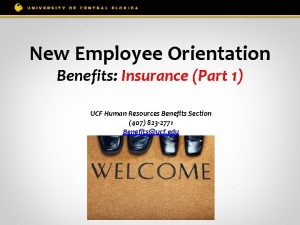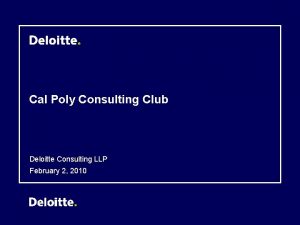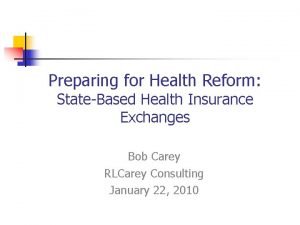Health Insurance Exchanges Steve Wander Principal Deloitte Consulting





















- Slides: 21

Health Insurance Exchanges Steve Wander, Principal, Deloitte Consulting LLP Sally Fingar, Sr. Manager, Deloitte Consulting, LLP February 15, 2011

Agenda Overview of health insurance exchanges Implementing health insurance exchanges Concluding thoughts Question & answer Copyright © 2011 Deloitte Development LLC. All rights reserved.

Overview of Health Insurance Exchanges

Exchanges are a lynchpin of reform The Affordable Care Act establishes State health insurance exchanges (HIX) as regulated, online marketplaces for individual and small group coverage • Administered by States within Federal guidelines • Targeting individual consumers and small groups up to 100 employees in 2014 • Expanding to groups over 100 in 2017 at State discretion • Determine eligibility for Medicaid and CHIP and enroll individuals in those programs when appropriate • Administer Federal subsidies to individuals below 400% of the Federal poverty limit • Offering comparable products, pricing and consumer information • Operating at State, sub-state or regional level 3 Copyright © 2011 Deloitte Development LLC. All rights reserved.

Exchanges must fulfill a broad range of roles and responsibilities Advisor / Navigator Marketing / Public Outreach Eligibility / Subsidy Determination Provide assistance in navigating the shopping and enrollment process Promote the Exchange and regulate marketing of products and services Determine who may participate and who is eligible for subsidies Product Availability / Specifications Comparison Shopping Tools Decide which carriers and products will be available and what information is required Provide tools that consumers and small businesses can use to identify, review and select products and prices Customer Service Premium Collection / Reconciliation Federal / State Coordination Respond to inquiries, grievances and appeals Determine premium obligations and combine with subsidies to ensure payment for coverage Manage numerous intragovernmental data and process interactions and dependencies 4 Enrollment & Eligibility Maintenance Support standard enrollment processes and ongoing maintenance Copyright © 2011 Deloitte Development LLC. All rights reserved.

Exchanges aim to provide and enable consumer choice and affordability Exchanges will offer more standardized products, distribution and administration • Online Enrollment • Electronic Interfaces • Rating/pricing • Plan Designs • Quality & Patient Satisfaction Ratings HIX • CHIP/Medicaid Enrollment Product Design Pricing / Underwriting • Subsidy Administration • Risk Adjustment • Coordination with Medicaid / CHIP Sales & Distribution • Minimum essential benefits coverage • Guarantee issue and renewability • Standard marketing requirements • Actuarially-equivalent benefit packages ü Bronze: 60% ü Silver: 70% ü Gold: 80%, ü Platinum: 90% • Catastrophic for under 30’s • Limited underwriting ü Geography ü Family status ü Age (3: 1) ü Smoking (1. 5: 1) • Roles of brokers and rules for on versus off exchange products • Out-of-pocket limits • No pre-existing conditions • Standard quality, price, and satisfaction ratings Health Plan A Health Plan B Health Plan C Health Plan D Health Plan E Enrollment & Eligibility • Standardized enrollment • Online, mail , over the phone and in-person • Subsidy eligibility management • Coordination with Medicaid and CHIP • Risk adjustment • No annual or lifetime limits 5 Copyright © 2011 Deloitte Development LLC. All rights reserved.

Exchanges will develop over time Although not required until 2014, early work on defining exchanges has begun • Interim solutions: National web portal to compare plan options (Healthcare. gov) and Preexisting Condition Insurance Plan (PCIP) offerings 2010 2011 2012 • Federal grants available to sates to establish exchanges 6 • States establish an American Health Benefit Exchange and a Small Business Health Options Program (SHOP) Exchange • States may merge the two exchanges 2013 2014 2015 • Exchanges must be financially self-sustaining 2016 2017+ • States may allow groups (100+) to participate in Exchanges • The Federal government will provide a fall-back exchange for states that are not ready, willing or able Copyright © 2011 Deloitte Development LLC. All rights reserved.

States will implement Exchanges within Federal guidelines (or defer to Feds) Federal Role • Define broad rules for exchanges (definitions, enrollment periods, participation requirements, etc. ) • Define essential benefits package, underwriting rules, standard enrollment/eligibility forms • Create standards and guidelines for reinsurance and risk adjustment • Define standard process & data exchange to support eligibility, enrollment & subsidy administration • Define criteria for health plans to be “qualified” to offer products through exchanges • Set standards for quality & member satisfaction ratings of plans • Provide planning, development and operational grants to states (to 2015) • Determine if state exchanges will be operational by 2014, and provide a fall-back exchange for states that will miss the deadline • Contract with at least two multi-state plans to be offered on each exchange 7 State Role • Establish and launch individual and small group health insurance exchanges by January 1, 2014 (including passing any required legislation , issuing required regulations, establishing enrollment processes, etc. ) • Define the coverage area for each exchange and determine whether or not to merge the individual and small group exchanges • Determine whether to offer a State Basic plan • Define state-level market rules for sales on versus off the exchanges and the role of brokers/agents in the process • Certify plans to participate on exchanges and provide quality and member satisfaction ratings for each plan • Develop single eligibility and enrollment process for Medicaid/CHIP and exchange subsidies • Administer premium subsidies for individuals up to 400% FPL Copyright © 2011 Deloitte Development LLC. All rights reserved.

Many stakeholders play key roles in Exchanges Small Employers Individual Customers Brokers, Navigators, Community Partners • Select plan level(s) • Pay premiums • Track fines • • • Help customers enroll • Provide information • Role will likely vary by State Employees of Small Businesses Screen Compare plans & enroll Change plans Request mandate exemptions • • Screen Compare plans Enroll Change plans Health Insurance Exchange Business Processes and Systems • Submit plans for listing • Maintain plan info, benefits, quality, cost & providers • Receive enrollments and premiums Health Plans 8 • Support phone & mail enrollments • Help customers • Manage grievances • May aggregate premium payments Customer Service, Operations, Vendors • Receive eligibility referrals Social Services Programs • Set exchange business policy • Certify & rate plans • Approve exemptions • Make vendor / carrier selection Exchange Governing Body • Create rules • Send/receive tax, premium, & other information used for verification, enrollment, & risk adjustment Federal and State Agencies / Systems Copyright © 2011 Deloitte Development LLC. All rights reserved.

Implementing Health Insurance Exchanges

Exchanges are not a new concept They have been a topic of discussion for almost 20 years There are existing examples of health insurance exchanges which provide insight into: • Key design choices and potential models • Possible challenges/hurdles 10 Copyright © 2011 Deloitte Development LLC. All rights reserved.

Overview of statewide attempts to create Health Insurance Exchanges State Program Name Description Texas Purchasing Alliance • An insurance purchasing pool for small employers • Established in 1994, disbanded in 1999 Health Insurance Connector • A link between funding sources and health plans to establish one simplified market • Part of Massachusetts’ 2006 health care reform legislation • 190, 000 members in 2010 Caroliance • A regional alliance of small groups, with voluntary membership, to gain access to health insurance • Established in 1992, disbanded in 1997 Health Insurance Plan of California / Pac. Advantage • Exchange was privatized and renamed in 1999 • Peak enrollment: 150, 000 members, 10, 000 small businesses • Closed in 2006 when one of the three insurers pulled out due to financial losses Utah Health Exchange • An exchange without an employer or individual coverage mandate • Piloted to 100 small businesses in August 2009, large employers in April 2010. 433 members in 2010. Connecticut Business and Industry • Provides choices of group health insurance to employees Association (CBIA) Health of small businesses Connections • Established in 1995 and has 75, 000 member in 2010 Washington Health Insurance Partnership (HIP) Texas Massachusetts North Carolina California 11 • Improves access to employer-sponsored coverage for small employers • Enrollment began in September of 2010 and coverage began in January of 2011 Copyright © 2011 Deloitte Development LLC. All rights reserved.

Exchanges: Key challenges in past attempts Description of Challenge Inability to Gain Adequate Market Share Inability to Command Lower Prices Adverse Selection Failure to Reduce Administrative Costs Low Agent Participation IT Deficiencies Challenges of State Sponsorship Challenges of Third Party Administration 12 State Examples ¡ Market share often remained too small to exert purchasing power, achieve economies of scale, and attract and retain health plans Texas, North Carolina, California, Massachusetts (for small group) ¡ Price disparities arose between coverage offered inside and outside the exchange. Exchanges competing with regular market for the same customers were challenged in obtaining lower prices California, Utah ¡ Insurers pushed high-risk individuals toward the exchange, which increased premiums and led to the departure of many employers ¡ Increased costs of serving small employers were not eliminated by centralizing the administration. Cost savings required large enrollment to achieve economies of scale. In some cases, health plans’ costs rose further due to inflexibility in administrative procedures of the exchange ¡ Lower commissions or threat to bypass agents generated hostility and an inability to successfully market products Texas, North Carolina, California Texas, North Carolina, Massachusetts ¡ Lack of system capabilities, including IT compatibility and connectivity, can limit administrative simplification, health plan participation, and ability to deliver innovative offerings Utah, Massachusetts ¡ Association with government can hurt more than help, as small businesses, and especially insurance agents, tend to be suspicious of government. In addition, a public organization is less likely to easily test out and adopt new strategies Texas ¡ Introducing an administrator with a vested interested in the competitive environment can prevent participation of plans Texas Copyright © 2011 Deloitte Development LLC. All rights reserved.

Marketplace design is driven by several considerations States may adopt one of a range of models – the design will be primarily driven by each State’s respective Strategy, Environment, Markets and ability to leverage existing assets Capability Model Environment/Market • Law mandates that a core set of capabilities/processes must be present (i. e. , eligibility verification, plan comparison, etc. ) • However, there appears to be significant flexibility in how robust these capabilities need to be in the exchange itself Robust Capabilities “Thin” Capabilities Driver Funding Thin Capabilities Budget Deficit Robust Capabilities Budget Surplus • States have considerable leeway in the degree by which they balance competition with appropriate regulation Competitive Driver Regulated Competitive Regulated Political Landscape Republican Majority Democratic Majority Regulatory Environment Limited regulatory oversight. State reinforces competition and growth Extensive regulatory oversight and limits competitive forces State Infrastructure Long and stringent procurement Flexible procurement cycles Population Demographics Fewer uninsured; healthier population Larger state, high population of uninsured individuals; less healthy population Broader Reform Policy Goals Exchange is not viewed as a mechanism to promote broader health policy Exchange is viewed as a vehicle to promote broader health policy Limited enrollment Majority of health insurance purchased through insurance exchange Risk and Selection Exchange may attract consumers with greater healthcare needs Regulations could help create a level playing field inside and outside the exchange Exchange Goals 13 Copyright © 2011 Deloitte Development LLC. All rights reserved.

Purpose Federal Funding Planning Grants Early Innovator Grant Program Establishment Grants • Support early development & implementation planning • Assist states with design and implementation of exchange IT infrastructure • Support costs & activities associated with Exchange implementation • Covers planning costs, including • IT system assessments • Performance metrics Development Timing • July 2010 Awards • RFP released Oct. 29, 2010 • Announced Jan 20, 2011 • Proposals due Dec. 22, 2010 • States choose when & for which type of grant to apply • Awards (up to 2 years) in Feb. 2011 • $49 million 14 • Create re-usable tools encourage multi-state cooperation • $1 million grants to each of 48 states and the District of Columbia • Alaska and Minnesota did not accept grants • Cooperative agreements, not grants • No match required, no specified award size limit • Up to 5 awards to individual states or consortium of states • Level 1: up to one year of funding to states that have made planning progress. States may apply for an additional year of funding. • Level 2: funding through December 2014 to states that are further along in their planning process and that meet specific criteria Copyright © 2011 Deloitte Development LLC. All rights reserved.

Concluding Thoughts

Concluding Thoughts Although we know that Exchanges will be transformational, we’re not quite sure what they will actually look like • Health insurance exchanges are the lynchpin of expanding access under Federal health care reform • There is no perfect model – different models will work in different markets. Flexibility in standards will be critical • States have to start building the house, even before the blueprints are complete • Successful implementation will require extensive collaboration between plans, the Federal government and the states • States have the experience and a track record of innovating and implementing complex programs…. exchanges will be no different • 2014 might seem like a long way away, but it is just around the corner 16 Copyright © 2011 Deloitte Development LLC. All rights reserved.

Question and Answer

Contact info Steve Wander Principal Deloitte Consulting LLP swander@delotite. com 612 -397 -4312 18 Sally Fingar Sr. Manager Deloitte Consulting LLP sfingar@deloitte. com 612 -659 -2627 Copyright © 2011 Deloitte Development LLC. All rights reserved.

About Deloitte refers to one or more of Deloitte Touche Tohmatsu Limited, a UK private company limited by guarantee, and its network of member firms, each of which is a legally separate and independent entity. Please see www. deloitte. com/about for a detailed description of the legal structure of Deloitte Touche Tohmatsu Limited and its member firms. Please see www. deloitte. com/us/about for a detailed description of the legal structure of Deloitte LLP and its subsidiaries

 Deloitte health insurance
Deloitte health insurance Deloitte consulting
Deloitte consulting Dawn peek yearn hose
Dawn peek yearn hose I wonder as i wander poem
I wonder as i wander poem Wander join
Wander join Wander and wonder
Wander and wonder Steve jobs steve wozniak and ronald wayne
Steve jobs steve wozniak and ronald wayne Six exchanges dialogue
Six exchanges dialogue Exchanges over trillion trading volume this
Exchanges over trillion trading volume this The role of internet exchanges and peering
The role of internet exchanges and peering Features of fire insurance
Features of fire insurance 20 principles of community health nursing
20 principles of community health nursing Tertiary prevention example
Tertiary prevention example Texas tech webraider
Texas tech webraider Fau employee benefits
Fau employee benefits Umms benefits
Umms benefits Blue cross tonik plan
Blue cross tonik plan Ouhsc pa program
Ouhsc pa program Raksha health insurance tpa
Raksha health insurance tpa Ucf insurance
Ucf insurance Health insurance market segmentation
Health insurance market segmentation What is deductible in health insurance
What is deductible in health insurance

